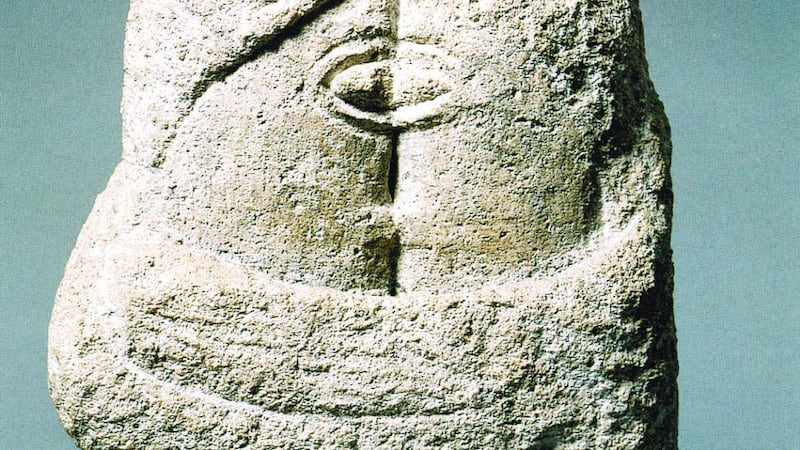What We Call Love: From Surrealism to Now
Works by modern and contemporary artists, including Dalí, Duchamp, Giacometti, Oppenheim, Picasso, Warhol, Yoko Ono, Nan Goldin and Damien Hirst
Irish Museum of Modern Art, Dublin

****
Bertrand Russell once described matter as a convenient formula for describing what happens where it isn't. The more you anatomise it, the less there seems to be to it: it's virtually all empty space.
Christine Macel, the curator of What We Call Love at Imma, takes a similarly hands-off view of her subject. Who knows what love is, she might as well ask. Beats me, is her answer. Yet you know love when you feel it, in whatever form it might take.
So, in surveying representational art from the beginning of the 20th century, she’s looking for evidence of love, or, as she puts it, looking at how love is, not what it is, and asking how artists manage to express it and describe it.
Moments of change
She looks to moments of change, when things were shaken up and new avenues of exploration opened up. She zeroes in on three main examples. The first is the surrealist movement in the 1920s, when artists took the Freudian idea of the unconscious and plunged right in.
The second is the burgeoning of conceptual and performance art from the 1960s through to the 1980s. At first glance this might seem unlikely: much conceptualism is relatively chilly and austere. But she mostly has in mind the countercultural influence, best exemplified in the benign, anti-war, utopian ideals of the era, with Yoko Ono and John Lennon as star exhibits. They feature, for example, in their Montreal Bed-In from 1969.
The third strand is art of today and the recent past. Here she sees the "increasing demands of certain minorities, such as the homosexual community, creating new definitions of concepts like gender". The terms "certain minorities" and "concepts like gender" introduce a note of vagueness, but her take on the surrealists is anything but. She narrows it down to the idea of amour fou or "mad love": instantaneous, absolute and final. And usually heterosexual, if not phallocentric, as the wealth of surrealist works on view confirm.
Brancusi's lovers in The Kiss are not just joined; they are minimally delineated, cut out of a single piece of limestone. Kisses don't fare well from that point on. In Picasso's 1931 painting of the same title there's arguably no love at all in the bristling, predatory engagement of male and female. It could reflect the artist's view of women or perhaps more his dislike of being ambushed by his own feelings. The emotional blankness of the many couples, gay and straight, kissing in one of Andy Warhol's early experimental films, Kiss, is typical of him. If Picasso comes across as hating emotional vulnerability, Warhol's jaded persona seems – and perhaps likes to seem – perplexed by the very notion of feeling.
Contrast that with the heightened tension of Marina Abramovic and her collaborator Ulay's performance piece Rest Energy. It's represented by a still image, but you get the idea. For four minutes as they stood in close proximity, Ulay held a drawn bowstring, its arrow aimed directly at her heart, Cupid to her Venus. It was, as she noted wryly, about total trust. But a recording of both their heartbeats conveys the effort and the nervousness.
Wedding bells
Love . . . and marriage? There's a lot of the latter in evidence, usually in the form of wildly inventive, distorted or subversive reworkings of the ritual by a number of performance artists, from the downright funny to the strange. The latter term applies to photographic documentation of Rudolf Schwarzkogler's 1965 Aktion Hochzeit, which involves the enactment of a bizarre ceremony that manages to explore the fundamental symbolism and oddity of formalised marriage as a cultural institution and semi-mystical rite.
Sophie Calle has been recurrently drawn to the end of love and the dissolution of her own relationships in her narratively driven autobiographical work. No Sex Last Night is quite rigorous and extreme, even by her standards. A dual video diary of her cross-country trip with Greg Shephard, the idea is that the trip will incorporate their marriage at a drive-in wedding venue at Las Vegas. There are no compelling reasons for this: love as such is not evident, and later we learn he is in love with another woman. In the end, Calle's determination and emotional resilience are remarkable, and she manages to reveal much about the nature of relationships.
Jochen Gerz, now better known for his large-scale public art projects – including at Ballymun in Dublin – is represented by a photo-text series from 1980, Le Grand Amour (Fictions) #1, which recalls the mood of black-and-white French Nouvelle Vague cinema from the 1960s. It is conceptually cool but somehow emotionally warm. Equally cool is Félix González- Torres's elegiac minimalism in works made in memory of his partner, against the background of Aids, which eventually claimed his own life.
What We Call Love is a big show. There is a vast amount of material to get through, a lot of it durational. But it's mostly involving and thought-provoking. It's likely that your first contact with it will be Volvo, arrangement, a witty 1986 installation piece by Ange Leccia. Two Volvos are parked head to head in the centre of the courtyard, their headlights illuminated. There is, you could say, electricity between them. It's a nice intro. You could easily miss Lucy Andrews's contribution: a single, discarded glove on the ground: a humble signifier of intimacy and abandonment.
In a way, like matter in Russell’s formulation, the closer Macel looks at love, the less there is of it. So often what we see seems to circle around it, aspire to it, note its loss, its possibility or impossibility, its promise. But then, perhaps it’s good that love proves so difficult to pin down.
- Until February 7th, 2016, €5-€8, imma.ie










